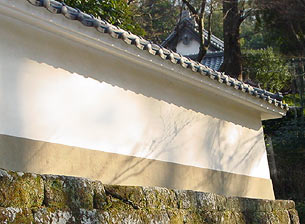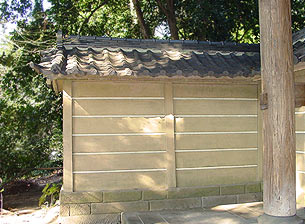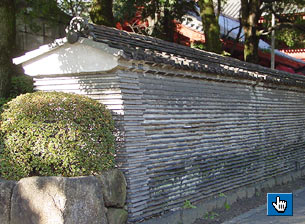| Also
called tsuijibei zn»; tsuigaki z_ or zÔ. A formal
style fence made by pounding a mixture of mud and clay between wooden frames *seki-ita Â. The process used to make a fence tsuiji, is called *hanchiku Åz. Slanted posts *subashira
{, are set 1.8m-2m apart so that the fence as seen in cross section is
broader at the base than at the top. The horizontal timbers that run between
these posts are called jougisuji èKØ. The posts at each end are called
kaigatabashira L`. Usually, a tiled *kawara
¢, gable roof *kirizuma
yane ØÈ®ª, is constructed on top of the most formal type of
fence. Cypress bark *hiwadabuki
Oç, roofing was sometimes used. Mud fences without a wooden framework or
a roof but reinforced with broken rock tiles, are called *dobei
y». Sometimes boards were used to cover the top of a simple mud fence. These
are called agetsuchi tsuiji ãyzn. Sujibei Ø» are fences decorated
with tile fragments and white lines, placed near the joints of the boards
that support the pounded mud-clay. Five parallel white plaster lines signify
nobility and monzeki ji-in åÕ@,
to which a member of the imperial family has retired. A *neribei
û» fence is constructed with alternate layers of dried clay bricks and kneaded
mud. It is sometimes made of boards with only the front side plastered.
A large tsuiji is called *oogaki
å_. The earliest extant tsuiji dates from the Kamakura period.
An example exists at Nishi no Miya Jinja ¼{_Ð in Hyougo
prefecture. |





